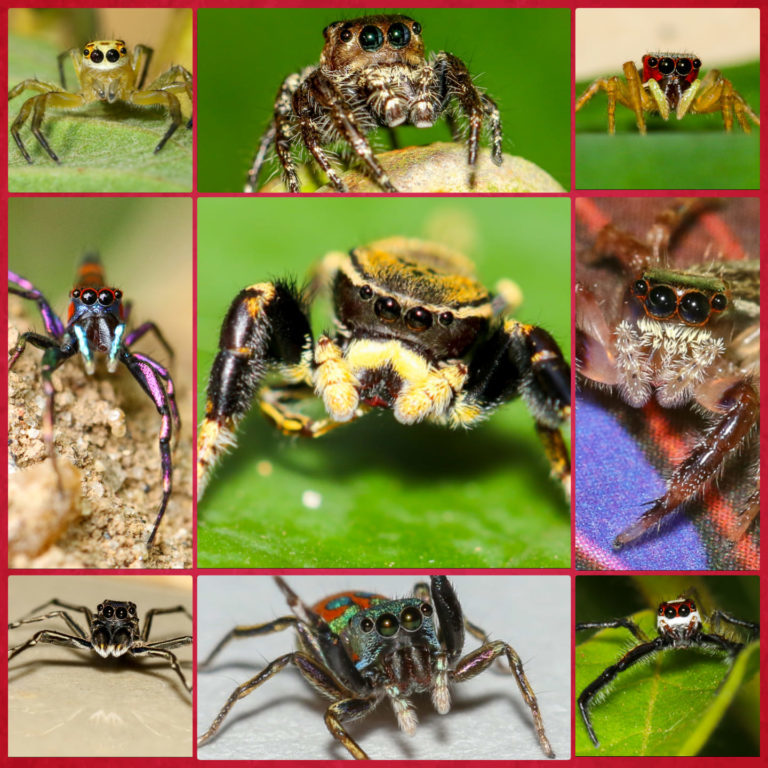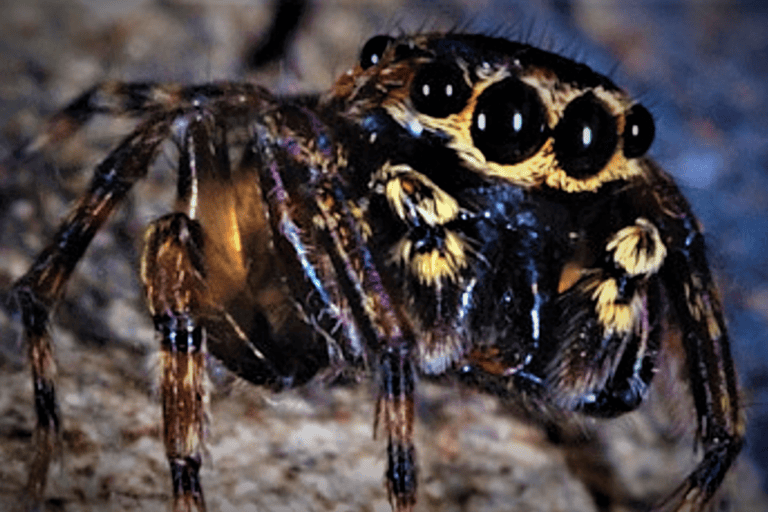- A new genetic analysis of the jumping spider genus Flacillula has purged unrelated species and described seven new ones, all endemic to Sri Lanka.
- The genus had been little studied since the type species, F. lubrica, or the oriental jumping spider, was described in 1901.
- Now, it’s joined by seven other species that have been named in honor of historical figures and places where the spiders occur.
- The discovery brings to 159 the number of jumping spiders (family Salticidae) found in Sri Lanka, and puts the island’s total number of spider species at 626.
COLOMBO — With two large eyes on a flat rectangular face, and six more eyes around the head, jumping spiders from the Salticidae family can look a bit alien, even by arachnid standards.
But all those extra eyes give it unparalleled vision — a prerequisite for the ability to jump long distances when in danger or hunting. Salticidae is also the largest family of spiders of the world, accounting for 13% of all known spider species. And now it’s grown a little bigger, thanks to a new study that describes seven new members of the jumping spider family from the biodiversity gem of Sri Lanka.
The new species were described as a result of an effort to clear up the evolutionary family tree in the genus Flacillula, from which the type species, Flacillula lubrica, had been described more than a century ago from Sri Lanka. Since then, five other spiders have been place in the genus.
But study co-authors Dilini Bopearachchi and Suresh Benjamin, both from Sri Lanka’s National Institute of Fundamental Studies, sought to review the composition of the genus, which, they wrote, had been rendered a “holdall” for several unrelated species due to its “ambiguous circumscription.”

Tiny masters of camouflage
So they traveled to different areas to cover all the climatic regions of Sri Lanka over a long period of time, collecting 24 individuals of Flacillula spiders in the process. What they found was that “many of these are not actually Flacillula species, where the genus has been used as a holdall, so we have also cleansed many of these ambiguities with the study,” Benjamin told Mongabay.
The study now establishes that the genus Flacillula consist of eight known species including F. lubrica: F. dothalugala, F. ellaensis, F. henryi, F. hodgsoni. F. johnstoni. F. naipauli and F. piyasenai.

Jumping spiders are an interesting group to study, Benjamin said. They hunt during the daytime, when their remarkable vision helps them find prey. Some are masters of camouflage, and many have interesting courtship displays in the form of dances. Sri Lanka is home to some of the most colorful jumping spiders, and the new descriptions raises the number of jumping spiders found on the island to 159, out of a total number of spider species here of 626.
The spiders of the genus Flacillula have small bodies that are round to oval, propped up on a robust first pair of legs with one spine, and six other legs that are spineless. As spiders go, they’re miniscule, measuring about 3-4 millimeters, or about an eighth of an inch.
The main threat they face, as with many other species across Sri Lanka, is habitat destruction.
“All these seven new species described are known from relatively few individuals and have a restricted range, so they may be considered as endangered,” Benjamin said.

Honoring places and historical figures
Two of these newly described species, F. dothalugala and F. ellaensis, are named after the areas where they were found: Dothalugala in the Knuckles Mountain Range in Central province, and the Passara Ella road in Uva province. F. piyasenai is been named after co-author Bopearachchi’s father, Piyasena Bopearachchi.
The other four newly described species are named in memory of distinguished global citizens. Benjamin, an avid reader and literature buff, chose to name F. naipauli after the late British author V.S. Naipaul, winner of the 2001 Nobel Prize in Literature. F. henryi is named after the late George Morrison Reid Henry, a former curator of systematic entomology at Colombo Museum. Commonly known as G.M. Henry, he also wrote the book Guide to the Birds of Ceylon, first published in 1955 and since regarded as a must-have for birders on the island. F. hodgsoni, meanwhile, honors the late Brian Houghton Hodgson, a pioneering naturalist and ethnologist who worked in India and Nepal.
F. johnstoni is named in honor of the late Alexander Johnston, who was neither a naturalist nor a prominent author. Johnston served in the early 1800s as chief justice of Ceylon (as Sri Lanka was then known), during which time he introduced administrative and legal reforms that gave native Sri Lankans greater rights. He was also a founding member of the Royal Asiatic Society.
Citation:
Bopearachchi, D. P, & Benjamin, S. P. (2021). Phylogenetic placement of Flacillula strand, 1932 with seven new species from Sri Lanka (Araneae: Salticidae). Journal of Zoological Systematics and Evolutionary Research, 59(6), 1255-1272. doi:10.1111/jzs.12485
Some of the newly described jumping spiders seen through a microscope. Image courtesy of Suresh P. Benjamin.
